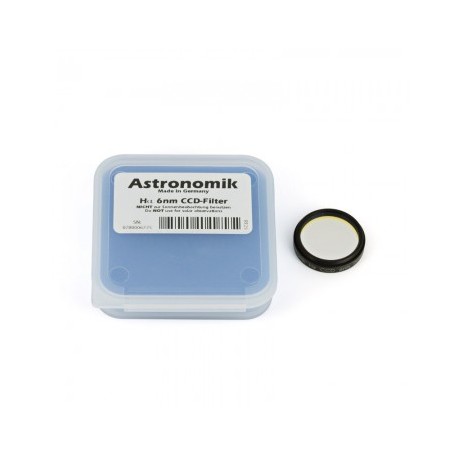No products
Prices are tax included
 View larger
View larger
Astronomik H-alpha 6nm 1.25" CCD/CMOS Filter
Filtre CCD H-Alpha 6nm
New product
Astronomik H-alpha 6nm 1.25" CCD/CMOS Filter
The Astronomik H-alpha 6nm 1.25" filter transmits 96% at 656 nm. Suitable for CCD and modern CMOS cameras, it blocks light pollution and enhances emission nebulae contrast. Ideal for monochrome narrowband astrophotography.
This product is no longer in stock
More info
Astronomik H-alpha 6nm 1.25" CCD/CMOS Filter
Description
The Astronomik H-alpha 6nm 1.25" is a narrowband filter tailored for astrophotography of emission nebulae in the H-alpha line at 656 nm. It is compatible with both CCD and modern CMOS sensors, making it an excellent tool for astrophotographers using monochrome imaging systems.
With a 6 nm full width at half maximum (FWHM), it efficiently blocks unwanted light from sodium and mercury vapor lamps, as well as skyglow. Its 96% peak transmission ensures high-contrast, sharp images, even from light-polluted urban locations.
The filter is equipped with Astronomik's MFR (Multi-Foil Reflection) coating and is optimized for optical systems as fast as f/4. It is mounted in a 1.25" threaded cell (M28.5), compatible with most filter wheels and accessories. Parfocal with other Astronomik filters.
Technical Specifications
-
Filter type: Narrowband H-alpha
-
Center wavelength: 656 nm
-
FWHM: 6 nm
-
Typical transmission: 96% at 656 nm
-
Mount: 1.25" (M28.5) threaded cell
-
Glass thickness: 1 mm
-
MFR Coating: Yes, optimized up to f/4
-
Parfocal: Yes (with Astronomik filters)
-
Sensor compatibility: CCD and modern CMOS (monochrome)
-
Recommended use: Astrophotography only
-
Durability: Scratch, humidity, and aging resistant
Advantages
-
High transmission at 656 nm for sharp contrast
-
Compatible with CCD and modern CMOS sensors
-
Excellent for urban or light-polluted skies
-
Sturdy 1.25" threaded mount
-
Parfocal with the entire Astronomik filter range
The Astronomik H-alpha 6nm 1.25" filter is ideal for astrophotographers looking to capture emission nebulae with outstanding clarity. Fully compatible with both CCD and modern CMOS sensors, it isolates the H-alpha emission line while blocking most sources of light pollution. It ensures superb contrast and signal quality, even with fast optics and in urban skies.


